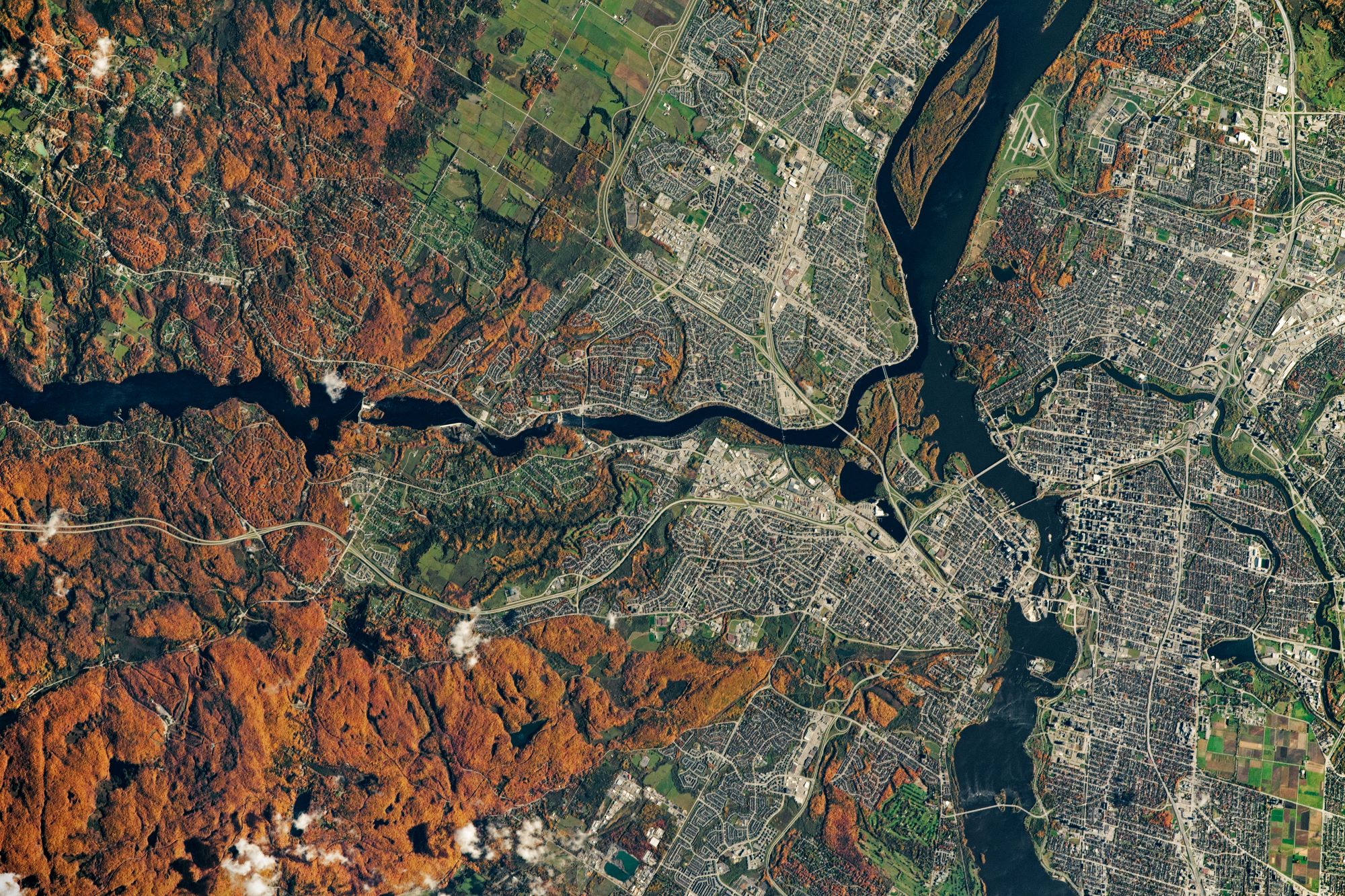[:ja]宇宙飛行士がISSから撮影した紅葉が始まったカナダの首都オタワの紅葉の様子です。ダウンタウン西方のガティノー公園のサトウカエデやヒッコリーの葉が色づき、紅葉が進んでいるのがわかります。

カナダには連邦政府の特別地区(Capital District)が存在せず、首都オタワはオンタリオ州内の一都市となっており、行政レベルはトロントなどと同じ単一層自治体に位置づけられます。ケベック州に隣接するため、フランス語系住民の数は12万人に上り、ケベック州以外の都市では最大です。また、首都としては、モンゴルのウランバートル、カザフスタンのアスタナに次いで、寒さの厳しい都市です。ケッペンの気候区分では亜寒帯湿潤気候(Dfb)に属し、冬季は1月の平均気温は-10.3℃。北極寒波に覆われると-30℃以下まで下がり、日中でも氷点下20℃以下までしか上がらないことも珍しくありません。冬季には完全に凍りついたリドー運河がスケートリンクに変身し、通勤・通学する市民で賑わう姿はオタワの風物詩になっています。
地上の様子はこちらです。

参考文献: Fall Color in Ottawa (NASA Earth Observatory)
地球俯瞰画像を見る: LiVEARTH
[Earthview Wonders] No.1149: Fall in Ottawa🇨🇦
Astronaut on board ISS captured Ottawa, the capital of Canada where reddening of the fall just started. West of downtown Ottawa lies Gatineau Park, where sugar maple leaves turn orange-red and hickories turn golden-bronze during the season.

Ottawa stands on the south bank of the Ottawa River in the eastern portion of southern Ontario. Founded in 1826 as Bytown, and incorporated as Ottawa in 1855, the city has evolved into the political centre of Canada. The city name Ottawa was chosen in reference to the Ottawa River, the name of which is derived from the Algonquin Odawa, meaning “to trade”. Ottawa has the most educated population among Canadian cities and is home to a number of post-secondary, research, and cultural institutions, including the National Arts Centre, the National Gallery, and numerous national museums. Ottawa has a humid continental climate (Köppen Dfb) with four distinct seasons and the average January minimum temperature is −14.4C. Snow and ice are dominant during the winter season.
The local scenery on the ground is as follows.

Reference: Fall Color in Ottawa (NASA Earth Observatory)
See earthview photo gallery: LiVEARTH[:en][Earthview Wonders] No.1149: Fall in Ottawa🇨🇦
Astronaut on board ISS captured Ottawa, the capital of Canada where reddening of the fall just started. West of downtown Ottawa lies Gatineau Park, where sugar maple leaves turn orange-red and hickories turn golden-bronze during the season.

Ottawa stands on the south bank of the Ottawa River in the eastern portion of southern Ontario. Founded in 1826 as Bytown, and incorporated as Ottawa in 1855, the city has evolved into the political centre of Canada. The city name Ottawa was chosen in reference to the Ottawa River, the name of which is derived from the Algonquin Odawa, meaning “to trade”. Ottawa has the most educated population among Canadian cities and is home to a number of post-secondary, research, and cultural institutions, including the National Arts Centre, the National Gallery, and numerous national museums. Ottawa has a humid continental climate (Köppen Dfb) with four distinct seasons and the average January minimum temperature is −14.4C. Snow and ice are dominant during the winter season.
The local scenery on the ground is as follows.

Reference: Fall Color in Ottawa (NASA Earth Observatory)
See earthview photo gallery: LiVEARTH[:]